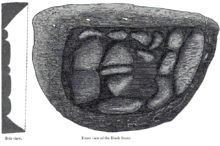The Black Stone (Arabic: الحجر الأسود al-Ḥajar al-Aswad) is the eastern cornerstone of theKaaba, the ancient stone building toward which Muslims pray, in the center of theGrand Mosque in Mecca, Saudi Arabia. It is revered by Muslims as an Islamic relic which, according to Muslim tradition, dates back to the time of Adam and Eve.[1]
The stone was venerated at the Kaaba in pre-Islamic pagan times. It was set intact into the Kaaba's wall by the Islamic prophet Muhammad in the year 605 A.D., five years before his first revelation. Since then it has been broken into a number of fragments and is now cemented into a silver frame in the side of the Kaaba. Its physical appearance is that of a fragmented dark rock, polished smooth by the hands of millions of pilgrims. Islamic tradition holds that it fell from Heaven to show Adam and Eve where to build an altar. Although it has often been described as a meteorite, this hypothesis is now uncertain.[2]
Muslim pilgrims circle the Kaaba as part of the Tawaf ritual of the Hajj. Many of them try, if possible, to stop and kiss the Black Stone, emulating the kiss that Islamic tradition records that it received from Muhammad.[3] If they cannot reach it, they point to it on each of their seven circuits around the Kaaba.[4]
Read More Click Below
Contents
[hide]Physical description
The Black Stone consists of a number of fragments held together by a silver frame, which is fastened by silver nails to the Stone.[5] Some of the smaller fragments have been cemented together to form the seven or eight fragments visible today. The Stone's exposed face measures about 20 centimetres (7.9 in) by 16 centimetres (6.3 in). Its original size is unclear; its recorded dimensions have changed considerably over time, as the stone has been remodelled on several occasions.[2]
In the 10th century, an observer described it as being one cubit (slightly over 1.5 feet (0.46 m)) long. By the early 17th century, it was recorded as measuring 1.5 yards (1.4 m) by 1.33 yards (1.22 m). According to Ali Bey in the 18th century, it was 42 inches (110 cm) high, and Muhammad Ali Pasha reported it as being 2.5 feet (0.76 m) long by 1.5 feet (0.46 m) wide.[2]
The Black Stone was first described in Western literature in the 19th and early 20th centuries by European travellers in Arabia, who visited the Kaaba in the guise of pilgrims.Swiss traveler Johann Ludwig Burckhardt visited Mecca in 1814, and provided a detailed description in his 1829 book Travels in Arabia:
It is an irregular oval, about seven inches in diameter, with an undulated surface, composed of about a dozen smaller stones of different sizes and shapes, well joined together with a small quantity of cement, and perfectly well smoothed; it looks as if the whole had been broken into as many pieces by a violent blow, and then united again. It is very difficult to determine accurately the quality of this stone which has been worn to its present surface by the millions of touches and kisses it has received. It appeared to me like a lava, containing several small extraneous particles of a whitish and of a yellow substance. Its colour is now a deep reddish brown approaching to black. It is surrounded on all sides by a border composed of a substance which I took to be a close cement of pitch and gravel of a similar, but not quite the same, brownish colour. This border serves to support its detached pieces; it is two or three inches in breadth, and rises a little above the surface of the stone. Both the border and the stone itself are encircled by a silver band, broader below than above, and on the two sides, with a considerable swelling below, as if a part of the stone were hidden under it. The lower part of the border is studded with silver nails.[6]
Visiting the Kaaba in 1853, Sir Richard Francis Burton noted that:
The colour appeared to me black and metallic, and the centre of the stone was sunk about two inches below the metallic circle. Round the sides was a reddish brown cement, almost level with the metal, and sloping down to the middle of the stone. The band is now a massive arch of gold or silver gilt. I found the aperture in which the stone is, one span and three fingers broad.[6]
Ritter von Laurin, the Austrian consul-general in Egypt, was able to inspect a fragment of the Stone removed by Muhammad Ali in 1817 and reported that it had a pitch-black exterior and a silver-grey, fine-grained interior in which tiny cubes of a bottle-green material were embedded. There are reportedly a few white or yellow spots on the face of the Stone, and it is officially described as being white with the exception of the face.[2]
The frame around the Black Stone and the black kiswah or cloth enveloping the Kaaba were for centuries maintained by the Ottoman Sultans in their role as Custodian of the Two Holy Mosques. The frames wore out over time due to the constant handling by pilgrims and were periodically replaced. Worn-out frames were brought back to Istanbul, where they are still kept as part of the Sacred Relics in the Topkapı Palace.[7]
For More below On Link

